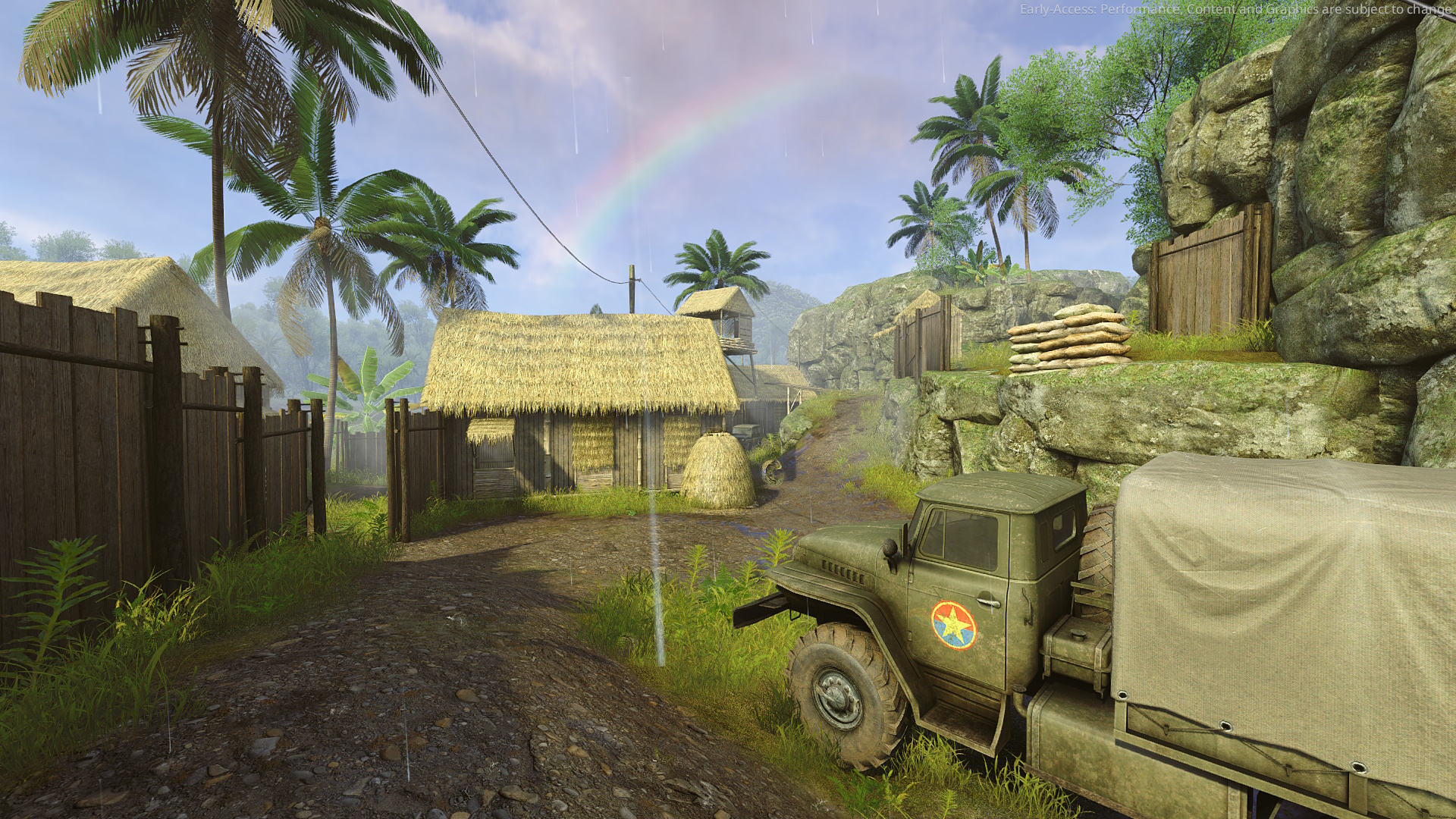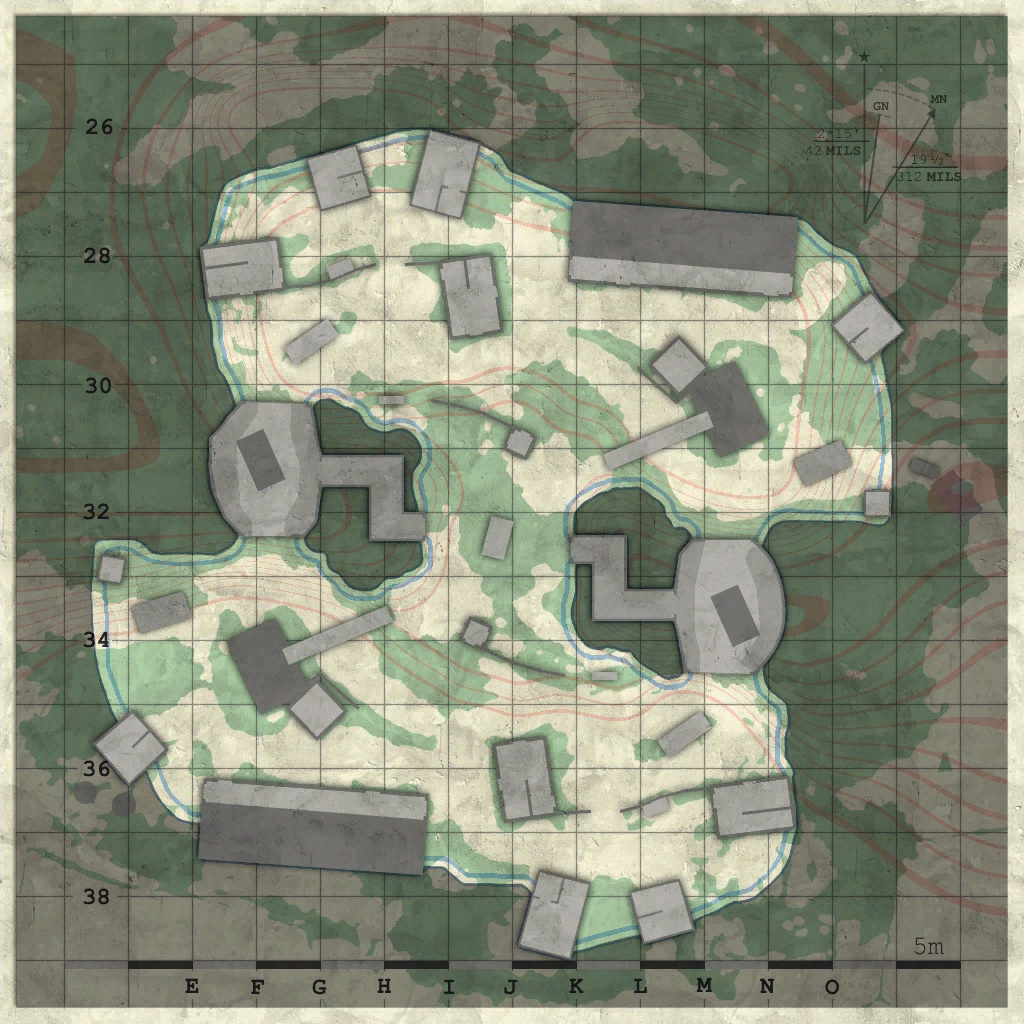NLF Outpost
Throughout the Vietnam War the United States Army has made use of long-range reconnaissance patrols (LRRP), well-trained and heavily armed reconnaissance teams. They would go on missions patrolling deep inside the enemy territory gathering intelligence on enemy positions and conducting counterinsurgency operations against the North Vietnamese Army and Việt Cộng.
Internal name: mcv_outpost.bsp
Supported gamemodes: Capture The Flag, Conquest, Deathmatch, Gungame, Gungame Deathmatch, Team Deathmatch
History of LRRPs in Vietnam
In December 1965, the 1st Brigade, 101st Airborne Division, formed a LRRP platoon, and by April 1966, the 1st Infantry Division, 25th Infantry Division and each of the four Battalions of the 173rd Airborne Brigade formed LRRP units as well. On 8 July 1966, General William Westmoreland authorized the formation of a (LRRP) unit in each infantry brigade or division in Vietnam. By 1967 formal LRRP companies were organized, most having three platoons, each with five six-man teams equipped with VHF/FM AN/PRC-25 radios. LRRP training was notoriously rigorous and team leaders were often graduates of the U.S. Army's 5th Special Forces Recondo School in Nha Trang, Vietnam.
Tiger Force was the nickname of an infamous long-range reconnaissance patrol unit of the 1st Battalion (Airborne), 327th Infantry Regiment, 1st Brigade (Separate), 101st Airborne Division, which fought in the Vietnam War, and was responsible for counterinsurgency operations against the North Vietnamese People's Army of Vietnam (PAVN) and Việt Cộng.
The platoon-sized unit, approximately 45 paratroopers, was founded by Colonel David Hackworth in November 1965 to "outguerrilla the guerrillas". Tiger Force (Recon) 1/327th was a highly decorated small unit in Vietnam, and paid for its reputation with heavy casualties. In October 1968, Tiger Force's parent battalion was awarded the Presidential Unit Citation by President Lyndon B. Johnson, which included a mention of Tiger Force's service at Đắk Tô in June 1966.
Since satellite communications were a thing of the future, one of the most daring long-range penetration operations of the war was launched by members of Company E, 52nd Infantry (LRP) of the 1st Air Cavalry Division, against the PAVN when they seized "Signal Hill" the name attributed to the peak of Dong Re Lao Mountain, a densely forested 4,879 feet (1,487 m) mountain, midway in A Shau Valley, so its 1st and 3rd Brigades, who would be fighting behind a wall of mountains, could communicate with Camp Evans near the coast or with approaching aircraft.
The US Marine Corps also performed long-range reconnaissance missions typically assigned to Marine Recon, especially Force Recon at the corps-level (i.e., Marine Expeditionary Force (MEF)) level, as opposed to the Battalion Recon units answering to battalion commanders. Marine Recon teams typically were twice as large as Army LRRPs and were more heavily armed, however, sacrificing a degree of stealth. In addition, the Marines did not employ indigenous Montagnards as front and rear scouts as Army LRRPs and Special Forces teams did which proved invaluable in confusing the enemy if contact was made. The tactical employment of LRRPs was later evaluated to be generally used far too dangerously by commanders, who were pleased by the kill ratios of LRRPs teams (reported as high as 400 enemy troops for every LRRP killed). Writes one commentator: "During the course of the war Lurps conducted around 23,000 long-range patrols, of this amount two-thirds resulted in enemy sightings." LRRPs also accounted for approximately 10,000 enemy KIA through ambushes, air strikes, and artillery.
In February 1969, all US Army LRRP units were folded into the newly formed 75th Infantry Regiment (Ranger), a predecessor of the 75th Ranger Regiment, bringing back operational Ranger units for the first time since the Korean War. The Army had inactivated Ranger units after Korea, but kept Ranger School, on the premise that spreading Ranger School graduates throughout the Army would improve overall performance. The initial Ranger companies formed in 1969 were: "A" V Corps, Fort Hood, Texas; "B" VII Corps, Fort Lewis, Washington; "C" I Field Force, Vietnam; "D" II Field Force, Vietnam; "E" 9th Infantry Division, Vietnam; F 25th Infantry Division, Vietnam; "G" 23d Infantry Division, Vietnam; "H" 1st Cavalry Division, Vietnam; "I" 1st Infantry Division, Vietnam; "K" 4th Infantry Division, Vietnam; "L" 101st Airborne Division, Vietnam; "M" 199th Light Infantry Brigade, Vietnam; "N" 173d Airborne Brigade, Vietnam; "O" 3d Brigade, 82d Airborne Division, Vietnam; and "P" 1st Brigade, 5th Infantry Division (Mechanized), Vietnam. Following its mobilization for Vietnam service, Company D (LRP), 151st Infantry of the Indiana Army National Guard completed its tour in Vietnam and, as it departed, Company D (Ranger), 75th Infantry was raised to replace it. Company F (LRP), 425th Infantry of the Michigan Army National Guard and Company E (Ranger) 65th Infantry of the Puerto Rico Army National Guard were not mobilized or sent to Vietnam. As National Guard units, D-151st, E-65th, and F-425th retained their regimental designations[35] and were not reflagged as companies of the 75th Infantry.
As the Vietnam War matured, I Field Force LRRPs widened their area of operation to include I Corps and II Corps, and II Field Force LRRPs respectively included III Corps and IV Corps.
SOURCE

